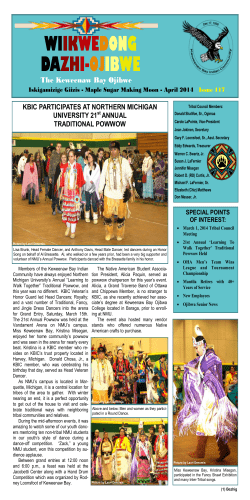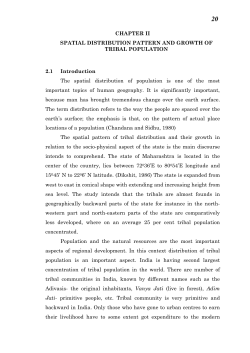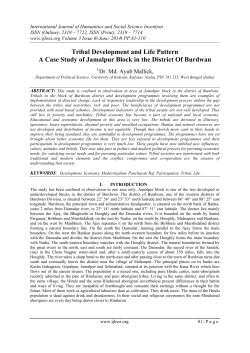
Serving Native American Children in Foster Care A cover story
cover story Serving Native American Children in Foster Care Lisette Austin A merican Indian and Alaska Native* children face a number of significant challenges. Many are born into communities that experience widespread poverty, substance abuse, domestic violence and chronic health problems at much higher rates than non-Native communities. US government policies that for years sought to eradicate American Indian culture, sovereignty and way of life contributed greatly to these tragic circumstances. While many tribes survived this onslaught, most are still navigating the psychological and physical aftermath of practices many consider to have been cultural genocide. According to national statistics, the general well-being of American Indian children trails significantly behind children from other ethnic groups. Recent research shows that while the US child mortality rate for children ages 1–14 has gone Photo courtesy of Alaska CASA down by 9% since 2000, it has increased by 15% entered foster care in 2005 and 2% of children in foster among Indian children. National data shows that Indian care waiting to be adopted. This disproportionality in the youth face higher rates of poverty, teenage suicide (nearly child welfare system happens at every step along the way, 2–2.5 times greater than Caucasian teens) and substance from the initial call to Child Protective Services (CPS) to abuse. According to the National Child Abuse and Neglect placement and court proceedings. Data System, American Indian/Alaska Native children experience a rate of child abuse and neglect of 16.5 per The Indian Child Welfare Act 1,000 as compared to 10.8 for Caucasian children. They are This current reality echoes a much darker period for overrepresented in the population of child maltreatment Native children. From the early 1800s until the 1970s, there victims at more than 1.6 times the expected level. In was a deliberate effort by the US government to “civilize” addition, studies show that Native children receive fewer and assimilate American Indians into mainstream American supportive services to promote stability, safety and general culture. Many Indian children were torn from their families well-being. and tribal communities, placed in boarding schools and Serious disparities also exist in relation to the US child forbidden to speak their native language. welfare system. Children and families of color, particularly By the 1970s, approximately 25–35% of all Native American Indian/Alaska Native and African-American children were being placed in institutions, foster homes children, are entering foster care at rates higher than or adoptive homes—three times the rate of non-Indian non-minority children—and they stay in care longer. children. Many suffered terrible abuse both in boarding According to a 2007 report by the National Indian Child schools and foster homes. These placements were rooted Welfare Association (NICWA), American Indian children in a system that did not respect or recognize American are represented at nearly two times the level expected. Indian cultures and instead sought to strip children of their Although Native children make up roughly 1% of the traditional ways of life. Congress finally responded to these national child population, they are 2% of the children who unjust practices by passing the Indian Child Welfare Act (ICWA) in 1978. * American Indian/Alaska Native is the terminology currently preferred by most tribal people and therefore by National CASA. However for the sake of variety and brevity, this term is alternated with Native American, Native and Indian throughout this issue. ICWA requires that every state court dependency case involving an American Indian/Alaska Native child adhere to specific requirements. The act generally requires that Native children, once removed, be placed whenever possible in homes that reflect their unique cultures and values—and that tribes be involved in placement decisions. These requirements are intended to protect the integrity and future of tribal communities by protecting their children’s cultural identity and tribal citizenship. And there is good reason to do so. “We know from research that American Indian children in the child welfare system who are connected to Native culture thrive and do much better than those who aren’t,” says Dr. Antony Stately, a clinical psychologist at the University of Washington who is Ojibwe/Oneida. Stately’s career has focused primarily on child maltreatment and neglect, and he currently sits on King County’s Local Indian Child Welfare Advisory Committee. “We also know that Indian kids in foster care settings where they are disconnected from siblings, family and their culture are at much greater risk for behavioral and mental health problems,” Stately explains. “And unfortunately Native kids in foster care are less likely to receive therapeutic services and are more likely to be misdiagnosed and overmedicated as compared to Caucasian children,” he says. As important and well intentioned as the Indian Child Welfare Act is, it is not always followed. Thirty years after the act’s inception, the removal of American Indian children from their homes still happens at an alarming rate. Many end up disconnected from their tribal culture and extended family. ICWA is an unfunded mandate, and responsibility for its enactment often falls on the shoulders of the tribes—most of whom still struggle with severe poverty and lack of resources. “ICWA is usually followed only if people make enough noise or have enough resources,” says Stately. “The reality is that many judges, caseworkers and advocates are still largely unaware of the importance and specific requirements of ICWA,” he says. Organizations such as the National Indian Child Welfare Association are working tirelessly to help ensure that ICWA is followed in all placement cases involving American Indian/Alaska Native children. Other organizations involved in foster care issues, such as the National CASA Association and the Annie E. Casey Foundation, are also taking significant steps to raise awareness about how best to advocate for American Indian children in the child welfare system and follow the important mandate of ICWA. CASA Tribal Programs Tribes are sovereign nations and therefore have the power to make their own laws and have their own court system. There are over 500 federally recognized Native American tribes and Alaska Native villages—and more Tips for Advocates 1. Understand the purpose of ICWA. Learn as much about it as you can by studying the Volunteer Manual from National CASA’s Volunteer Training Curriculum, taking advantage of other training and visiting the websites listed under “Resources.” Help to make sure that this law is the guiding force in any dependency action involving an American Indian/Alaska Native child. 2. Find out as soon as you can whether the child you are working with has Native heritage. If so, bring this to the attention of child protective services and the court. Also review provisions of ICWA to determine whether it is being upheld in the case. 3. Do not assume that all lawyers, caseworkers and other child welfare service providers are aware of ICWA requirements. Educate those working on the child’s case as much as possible. 4. Find out whether the child is enrolled in her tribe. If not, find out what steps you need to take toward enrollment and tribal benefits. 5. Contact the child’s tribe and determine what resources are available to him (e.g., relative or tribal placement options, treatment programs for parents, housing options and educational placements). 6. Make every effort to learn about the child’s tribe. Most tribes willingly share information about their history and community (government, cultural events and activities). Create a fact sheet about the tribe for yourself. 7. Seek out activities that connect the child with his or her tribe and culture. Encourage contact between possible tribal placements and the Native child even while parents are working toward reunification. 8. Remember that every tribe is unique. Some have significant resources; some have very few. Avoid making broad assumptions. 9. Be willing to learn about and accept cultural values and perspectives that are not your own. Take time to build trust with the tribal community. Be respectful, a good listener and open-minded. 10. Acknowledge the reality of disproportionality and institutional racism in the child welfare system. Realize that you may need to advocate even harder for a Native American child. Ask important questions early. Has he had an evaluation? Are there culturally competent services available to the child? 11. Examine your perceptions and expectations about Native people. Understand the context in which many Indian children and families find themselves, most notably poverty. Try to place yourself in their shoes. 12. Recognize when you are in over your head or in uncharted territory. Ask for advice and support. Be humble and acknowledge that you do not know everything. —Compiled by the author from interview sources [Continued on page 8] The Connection—Winter 2009 [Cover Story continued from page 7] than 250 have tribal court systems in place. National CASA recognizes the need for advocacy in tribal courts, particularly advocacy provided by tribal community members. In 1995, National CASA began receiving funding from the federal Office for Victims of Crime to extend the CASA program into tribal courts. National CASA currently has 15 member tribal court CASA programs. All are west of the Mississippi and were initiated through requests from tribal communities. Some of the programs serve only specific tribes while others are dual jurisdiction, operating in both tribal and state courts. All of the tribal programs provide American Indian children with advocates who understand the importance of ICWA and take into account the child’s unique cultural background and tribal citizenship. There is an amazing amount of diversity among tribes, including differences in resources, government structure, geography and culture. Many tribes experience significant challenges in investigating and prosecuting cases of child maltreatment, while others are more successful. This means there cannot be a cookie-cutter approach when developing tribal court CASA programs. Fasana is also the tribal court administrator for the tribes, and she saw too often that when the tribal court stepped in, children who sometimes were not very involved with their community to begin with were left with a feeling of animosity toward the tribe. “We wanted to change that—and help them see that there is more to this tribe than the tribal child welfare system,” she explains. When Fasana was contacted a year ago by a local CASA program director who wanted advice on how to recruit more Native advocates, she saw a great opportunity. She presented information about volunteer advocacy to the tribe, which in turn decided to start its own CASA tribal court program. They contacted National CASA, and soon Fasana had recruited two volunteers from the tribal community. Creek Nation tribe member and CASA volunteer Sarah Sebring with her nephew. In March, 15 state agencies will honor the tribal court CASA collaboration between the Okmulgee County Family Resource Center and the Muscogee (Creek) Nation Tribe with a Partners Award at the 2009 Partnership Conference for Oklahoma Families. See page 19. “One must be very careful if making any assumptions about a tribal community,” says Michael Heaton, a regional program specialist for National CASA. Heaton serves as liaison between local programs and National CASA; his region encompasses nine western states and includes several tribal programs. “Tribes may seem similar but are often very different from each other, even if close neighbors,” says Heaton. He finds it important to recognize and honor each tribe’s unique culture and needs. “Much of my work with tribal CASA programs is learning about each tribe’s social, economic and cultural issues, then talking and working with tribal members to best serve their children.” For Angela Fasana, tribal member and CASA director for the Confederated Tribes of Grand Ronde in Oregon, the way to best serve their children is clear. “We are lucky here. We have an indigent defense fund, which means each child who comes into court gets representation,” says Fasana. “But what we were missing was a connection to the tribe.” Kym Miller is equally dedicated to the tribal children she serves. In 2008, Miller was hired as program coordinator for the Kenaitze Indian Tribal CASA Program in Kenai, Alaska. It is the only tribal court CASA program in the state and is funded by National CASA. When she came on board, the program had been in existence for three years but had only one advocate. Miller, who had recently moved to this remote community 150 miles from Anchorage, hit the streets and started getting to know people in the community in a very proactive way. “I met with elders, volunteered at the elementary school and other programs— did anything to meet and connect with the community.” Miller is Athabascan Alaska Native from Anvik, a very small community. She knew that if she wanted to engage the community in the CASA program, she first had to invest herself in the community and build trust. “That’s how Native culture is. It takes time to really develop a rapport [Continued on page 10] Fasana’s advocates not only participate in the regular CASA training process, they also undergo cultural training specific to the Grand Ronde tribes. This additional training stresses the importance of involving children in cultural activities so that they can come to know their tribal community, a major resource and support for them. “Exposing children to the tribe and to their culture is the driving force for this program. This is my big dream,” says Fasana. Resources for Advocating for Native Children in Foster Care The following websites, publications and organizations are helpful in understanding issues and strategies surrounding advocacy for American Indian/Alaska Native children in foster care. American Indian Tribes and Cultures (42explore2.com/native4.htm) This website provides links to other sites with information about specific American Indian tribes and cultures, including comprehensive index sites, sites about Native cultures and history as well as individual tribal websites. Indian Country Child Trauma Center (icctc.org) The Indian Country Child Trauma Center develops trauma-related treatment protocols, outreach materials and service delivery guidelines specifically for Native children and families. National Indian Child Welfare Association (nicwa.org) The National Indian Child Welfare Association is the most comprehensive source of information on Indian child welfare. NICWA works to address child abuse and neglect through training, research, public policy and grassroots community development. Their site also provides links to information on Native culture. National American Indian Court Judges Association (naicja.org) The National American Indian Court Judges Association is a national voluntary association of tribal court judges primarily devoted to the support of American Indian and Alaska Native justice systems through education, information sharing and advocacy. Native American Rights Fund (narf.org) The Native American Rights Fund is a nonprofit organization that provides legal representation and technical assistance to Indian tribes, organizations and individuals nationwide. NARF focuses on applying existing laws and treaties to guarantee that national and state governments live up to their legal obligations. Native Youth Magazine (nativeyouthmagazine.com) This online magazine focuses on the talents and lifestyles of Native youth in the US and Canada. It features commentaries, profiles, photos and artwork submitted by Native youth. Native Youth Magazine provides an opportunity for American Indian/Alaska Native youth to tell their stories and also explore the world of journalism. The Connection—Winter 2009 “Soul Wound: The Legacy of Native American Schools” This article published by Amnesty International USA gives an overview of the devastation caused by almost 100 years of policies that forced Native children to attend Christian boarding schools. The article can be viewed at amnestyusa. org/amnestynow/soulwound.html. “ICWA and CASA/GAL Volunteers: Advocating for the Best Interests of Native Children” This 2001 article was written by Judge Abby Abinanti and published by National CASA in The Connection magazine. The article gives an overview of ICWA and discusses the importance of CASA advocacy for American Indian/Alaska Native children in foster care. It is available in PDF format at casanet.org/program-services/ tribal. From there, click on the article title under “Indian Child Welfare Act.” The Judges’ Page Newsletter (nationalcasa.org/JudgesPage) This online newsletter, published by National CASA and the National Council of Juvenile and Family Court Judges, is also a resource for CASA volunteers. The April 2004 issue, The Indian Child Welfare Act, outlines the history of ICWA, discusses judicial ethics and implementation of ICWA and includes an article about CASA advocacy in tribal courts. Tribal Court CASA (casanet.org/program-services/tribal) This section of National CASA’s resource website provides information about tribal court CASA programs. The section includes tips for starting and developing these programs, information about ICWA and links to related organizations. Tribal Court Clearinghouse (tribal-institute.org) This clearinghouse was developed by the Tribal Law and Policy Institute, an Indian-operated nonprofit that develops education, research, training and technical assistance programs to enhance justice in Indian country as well as the health, well-being and culture of Native peoples. The clearinghouse provides extensive resources about tribal, federal and state laws that affect Native peoples, including the full text of ICWA. Understanding the Justice of ICWA Hon. Abby Abinanti Many people, when initially faced with issues involving American Indian children, grapple with the concept of different treatment for Indian children. Some may feel it is not fair to the child to be treated differently, to have different rules than non-Indian children. It is the CASA volunteer’s job to understand and ensure that the Indian child’s special rights are acknowledged and secured. To be able to advocate in such a manner it is essential that the CASA volunteer understand the basis for this difference. It can best be understood as a citizenship right. Congress in passing ICWA essentially acknowledged the premise that an Indian child’s citizenship within the tribe is a valuable right to be protected for the child. Many tangible and intangible benefits flow from citizenship. The sovereign tribe has an interest in the welfare of each of its citizens. An Indian child’s rights as articulated in ICWA are not based simply on race or cultural considerations; they are based on the political relationship that exists between the United States and each of the recognized tribes. According to the law, these tribes are considered domestic, dependent nations and as such have a special relationship with the federal government that transcends the relationship of states to other citizens. Each Indian child has an interest in his or her tribe, and each tribe has an interest in each of its children. ICWA is designed to prevent inappropriate interference with this relationship. Excerpted from “The Indian Child Welfare Act and CASA: Advocating for the Best Interests of Native Children,” by Hon. Abby Abinanti, commissioner of the Superior Court of California and former member of the National CASA Board of Trustees, The Connection, Fall 2001. [Cover Story continued from page 8] with a tribe,” Miller says. “You have to show that you are a friend to the reservation community, that you are really interested in the ‘best good.’ If you do this, you will see the benefit.” And indeed she did. Within seven months, Miller had recruited ten new advocates into the Kenaitze Indian Tribal CASA Program. Roughly 75% of the advocates are Alaska Native and tribal members. The ones who are non-Native have strong ties to, and are respected by, the community. All of the advocates have received additional cultural training provided by the tribe’s cultural education program. Miller is now helping start other CASA programs in the state in places like Nome and Bethel. She feels that there is a very strong need for more programs. “We have horrible 10 statistics up here in Alaska. We’re the highest in suicide among Natives, including youth,” she says. She is grateful, however, to be in a state that strongly supports the Indian Child Welfare Act. “Up here in Alaska many people working with tribes are very aware of the importance of this act. We are lucky,” Miller says. Non-Tribal Court CASA Programs Serving Native Children There are many state court CASA programs that serve American Indian/Alaska Native children as well. Chad Catron, director of Rapid City, South Dakota’s Seventh Circuit CASA Program, says that approximately 60% of their cases involve American Indian children, predominantly from the Lakota Sioux tribes. Out of the program’s nearly 100 volunteers, only a few are Native. Because of this, Catron makes sure that his advocates receive additional training. “We bring in someone to do a half-day training on ICWA as part of the initial advocate training, and we also try to revisit it at least once a year,” Catron says. “There are also lots of trainings available in the area related to ICWA, so when those happen we try to get as many of our staff to attend as possible. We recognize the importance of ICWA in preserving Native culture.” Trainings also focus on cultural sensitivity. “Typically we have someone come from the ICWA office who is Lakota Sioux, and she talks about cultural awareness,” explains Catron. CASA volunteers are also encouraged to attend the many Lakota events that are available in the area and to connect with the tribes as much as possible. “Learning more about the Lakota culture goes a long way toward building trust with the Native children and families we serve,” he says. “The biggest thing that our advocates can do is learn about and understand the culture.” Diane Wilson, a CASA volunteer in the Rapid City program, agrees. “Often CASA advocates are unaware of cultural differences; for example how many Native cultures think direct eye contact is inappropriate,” says Wilson. “You’ll end up with advocates thinking a family is hiding something because they won’t look them in the eye.” Wilson also emphasizes the importance of recognizing differences in child-rearing practices, ways of speaking and the reality that not all tribes are the same. “As an advocate, you need to be very aware of these kinds of cultural differences and be very respectful toward the tribal community you are working with,” she says. There are, of course, many challenges for non-tribal court CASA programs that serve high numbers of Native children. A major one is recruitment of Indian volunteers. “That is something that has always plagued us, getting numbers of Native American volunteers up,” says Catron.
© Copyright 2025


















